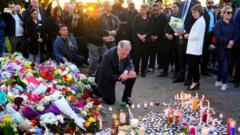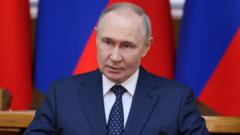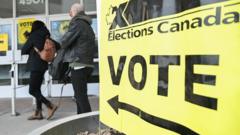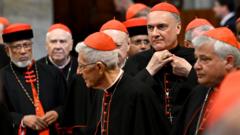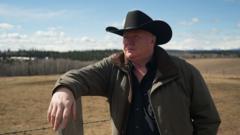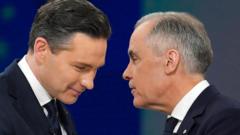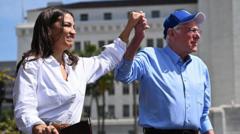In this election, Canadians are making a critical decision about their leadership, particularly in light of heightened tensions with the U.S. due to President Trump's policies. With the Liberal Party, under Mark Carney, having made a surprising comeback in recent polling after facing a significant deficit, voters are choosing not just parliamentary representatives but the direction of the nation during a tumultuous economic period.
**Canada's Pivotal Election: A Vote That Could Redefine National Leadership Amid Global Turmoil**

**Canada's Pivotal Election: A Vote That Could Redefine National Leadership Amid Global Turmoil**
As Canadians cast their votes today, the election outcome carries significant implications for the nation's political landscape amidst external pressures, particularly from the U.S.
The stakes are high as Canadians head to the polls today to elect their next leader against the backdrop of ongoing economic strife and U.S. pressure. The race features a tight contest between the incumbent Liberal Party and the Conservative Party, highlighted by recent shifts in voter sentiment that could reshape the country’s leadership and policies.
In the lead-up to the election, the political atmosphere in Canada has dramatically shifted. Opinion polls show a narrow advantage for the Liberal Party, led by newly appointed Prime Minister Mark Carney, over the Conservative Party led by Pierre Poilievre. Just months ago, the Conservatives boasted a substantial lead that fluctuated in the face of Trump's trade policies and the resignation of long-time Prime Minister Justin Trudeau.
As voters reach the ballot boxes, they will choose from three other parties while facing pressing national issues: the economy, inflation, and U.S. tariffs that have rocked Canadian industries. Candidates’ responses to Trump's threats, particularly about tariffs on Canadian goods, have been paramount in shaping public perception and influencing voter choice this election season.
The election process follows a standard parliamentary procedure where citizens vote for local representatives in their ridings, determining the party with the most seats in the House of Commons, which has 343 seats available. Although voter trends seem to favor the Liberals, particularly in populous regions like Ontario and Quebec, the outcome remains uncertain.
Prime Minister Carney is positioning himself as a stabilizing force capable of managing U.S. relations amid economic volatility. Meanwhile, Poilievre's critiques of the Liberal administration emphasize reducing government size and taxes to boost economic growth and independence from external influences.
As millions head to the polls, the reasoning behind voting choices is multifaceted. Issues like unaffordable housing, national sovereignty in the face of U.S. interference, and economic stability are pressing matters on the minds of Canadian voters. The results of this election will not merely highlight preferences for political leadership but will also reflect the changing dynamics of Canada’s national identity and its global standing.
Polls will begin closing at various times across Canada, with significant results expected late Monday evening as ballots are counted by hand. The outcome could redefine the political trajectory of Canada as it navigates its relationship with its southern neighbor.
In summary, as Canadians vote today, the implications of this election extend beyond mere leadership; they encompass economic strategy, national security, and the future of Canada’s democracy in a shifting global landscape.
In the lead-up to the election, the political atmosphere in Canada has dramatically shifted. Opinion polls show a narrow advantage for the Liberal Party, led by newly appointed Prime Minister Mark Carney, over the Conservative Party led by Pierre Poilievre. Just months ago, the Conservatives boasted a substantial lead that fluctuated in the face of Trump's trade policies and the resignation of long-time Prime Minister Justin Trudeau.
As voters reach the ballot boxes, they will choose from three other parties while facing pressing national issues: the economy, inflation, and U.S. tariffs that have rocked Canadian industries. Candidates’ responses to Trump's threats, particularly about tariffs on Canadian goods, have been paramount in shaping public perception and influencing voter choice this election season.
The election process follows a standard parliamentary procedure where citizens vote for local representatives in their ridings, determining the party with the most seats in the House of Commons, which has 343 seats available. Although voter trends seem to favor the Liberals, particularly in populous regions like Ontario and Quebec, the outcome remains uncertain.
Prime Minister Carney is positioning himself as a stabilizing force capable of managing U.S. relations amid economic volatility. Meanwhile, Poilievre's critiques of the Liberal administration emphasize reducing government size and taxes to boost economic growth and independence from external influences.
As millions head to the polls, the reasoning behind voting choices is multifaceted. Issues like unaffordable housing, national sovereignty in the face of U.S. interference, and economic stability are pressing matters on the minds of Canadian voters. The results of this election will not merely highlight preferences for political leadership but will also reflect the changing dynamics of Canada’s national identity and its global standing.
Polls will begin closing at various times across Canada, with significant results expected late Monday evening as ballots are counted by hand. The outcome could redefine the political trajectory of Canada as it navigates its relationship with its southern neighbor.
In summary, as Canadians vote today, the implications of this election extend beyond mere leadership; they encompass economic strategy, national security, and the future of Canada’s democracy in a shifting global landscape.

